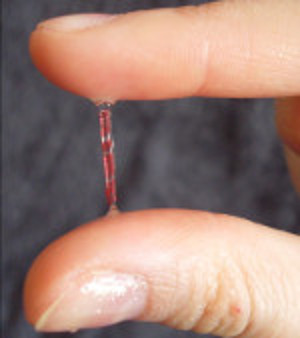
bloody discharge © fertility-tv.com
Bloody discharge – what does it mean? I’ll show you how to correctly interpret blood in vaginal discharge during ovulation and before your period.
Many women are very worried when they recognise bloody discharge in their underwear. However, there is no need to worry at first. Bloody discharge can occur during the menstrual cycle, but it needs to be interpreted differently depending on when it occurs. In this article, I’ll show you in which cycle phases bloody discharge occurs and how you can interpret it correctly.
Bloody discharge – where does it come from?
First of all, it’s important to know that discharge generally refers to all bodily fluids that run out of the vagina during the menstrual cycle. As a rule, discharge is made up of three bodily fluids.
#1 Vaginal fluid
Acidic vaginal fluid is produced by the epithelial cells and capillaries of the vagina. It is traditionally acidic and is intended to protect the body from pathogens such as fungi, bacteria or viruses.
#2 Cervical mucus
The alkaline cervical mucus, which is produced in special glands (crypts) in the cervix, is very important for the desire to have children. It changes cyclically and nourishes, filters and protects the sperm in the woman’s body. Thanks to the cervical mucus, the sperm in the woman’s body can wait three to five days for ovulation and remain fertile.
#3 Arousal Fluid
Arousal Fluid is produced in Bartholin’s glands in the vaginal area. In contrast to vaginal fluid and cervical mucus, which are present every day of the cycle, arousal fluid is only produced during sexual arousal. It acts as a natural lubricant against vaginal dryness to make sex more pleasurable.
Bloody discharge – where does it come from?
Healthy discharge is usually whitish to transparent in colour. However, if the discharge mixes with blood, bloody discharge occurs. This is more common during menstruation, for example, or in the case of
Bloody discharge – how can it be interpreted correctly?
It has already been clarified that bloody discharge can only occur when there is bleeding in the cycle. Depending on when this bleeding occurs in the cycle, bloody discharge can be interpreted differently.
Bloody discharge during your period

red bloody discharge during menstruation © fertility-tv.com
Every cycle begins with menstrual bleeding, which usually lasts between two and seven days. Most women have their heaviest bleeding within the first three days. After that, the bleeding usually becomes weaker and the discharge and menstrual blood mix. Brownish-coloured discharge is also observed more frequently here when the older period blood comes together with the vaginal discharge. Light red discharge, on the other hand, indicates fresh blood that was produced not too long ago.
Bloody discharge during ovulation
During ovulation, there is a very strong increase in estrogen and LH as well as other hormones. This hormonal imbalance can lead to the shedding of some of the uterine lining and thus to intermenstrual bleeding. This intermenstrual bleeding is also often referred to as ovulation bleeding, as it is a sign of ovulation and occurs at the time of ovulation. According to studies from 2012, ovulation bleeding is a very rare phenomenon that only 5% of women experience. Ovulation bleeding usually lasts only a short time and is also less intense than a period.
Bloody discharge before your period
Almost all women experience minor intermenstrual bleeding shortly before their period, which mixes with vaginal discharge. The mucous plug often dissolves shortly before menstruation, which is why some women experience a large amount of top-quality discharge. If the blood from the menstrual period mixes with the mucus plug, this results in bloody discharge before the period, which is completely normal.
Bloody vaginal discharge during implantation
According to some studies, implantation takes place between the 6th and 12th day after ovulation. When the zygote implants, part of the lining of the uterus may detach and bleed. This bleeding as a result of implantation is called implantation haemorrhage or nidation haemorrhage. If this implantation haemorrhage mixes with the normal discharge, this results in a bloody discharge during implantation. We have already explained in detail how you can recognise implantation bleeding in another article.
Bloody discharge during pregnancy
Of course, it is known that bleeding can also occur during pregnancy. However, in my experience, this is a warning sign. Bleeding usually indicates a lack of supply, and it can also be a sign of an impending miscarriage or ectopic pregnancy. Personally, I also experienced intermenstrual bleeding during my second pregnancy, most likely because I didn’t take enough folic acid before becoming pregnant or due to unexplained hormonal fluctuations. If you experience bleeding during pregnancy, please go to your doctor and have it checked out. Logically, bloody mucus can occur during pregnancy if the intermenstrual bleeding mixes with the normal white flow of pregnancy.
Bloody discharge after the pill
After stopping the pill, hormone withdrawal bleeding can occur because the body is in hormonal imbalance. The natural cycle first has to stabilise again and, according to studies, 50% of women experience irregular cycles, bleeding between periods and much more after stopping the pill. This can naturally lead to a mixture of hormone withdrawal bleeding and normal vaginal discharge. This results in bloody discharge after the pill, which disappears over time. Within a year, the natural cycle levels out again for most women.
Blood in the discharge – when to see a doctor?
It is important to know that healthy discharge is odourless and ranges from whitish, yellowish to transparent in colour. Reddish to brownish discharge can also occur in combination with the intermenstrual bleeding mentioned above. Healthy discharge does not normally cause any pain either. However, you should consult a gynaecologist if you experience these symptoms:
Itching and burning
If your vaginal area itches and burns, this may be an indication of an infection. Your doctor will find out which pathogen is behind this by taking a swab and can then treat you accordingly.
Green to black discharge
If green-yellowish or black discharge occurs during your cycle, this is usually a sign of an illness that should be checked by a doctor. Such mucus often occurs with sexually transmitted diseases or vaginal fungus. Purulent or flesh-coloured discharge indicates a serious illness and should be dealt with quickly.
Bleeding with pain during or after sex
If you experience pain and bleeding during or after sex, this could be related to an injury in the vaginal area or more serious conditions such as polyps, cysts or even cervical cancer. For this reason, I advise you to go to a gynecological practice in this case.
Bleeding during pregnancy
If bloody discharge occurs during pregnancy, this is usually a sign that something is wrong and for this reason it is advisable to have a doctor take a look. The old adage applies here: “Better safe than sorry.”
Correctly interpreting blood in your discharge – the best tips
To correctly interpret bloody discharge, you need to know exactly which phase of your cycle you are in.
#1 Determine your ovulation and your fertile days
If you want to have children, it is particularly important to know when you are ovulating so that you can get pregnant more quickly by having sex at the optimum time. With the NFP method, you monitor your discharge and temperature and enter them day by day in a cycle sheet. From the resulting temperature curve and the course of the mucus, you can pinpoint ovulation to within four days with 91% accuracy. Of course, you will also find out which phase of your cycle you are in, as ovulation divides the cycle into the egg maturation phase and the luteal phase. If you would also like to determine ovulation, fertile days and the length of the cycle phase with NFP, then take a look at my Get Pregnant Starter Set. There you will find all the information you need to get started with NFP straight away.
#2 Look out for other symptoms
In addition to ovulation bleeding, ovulation is usually accompanied by other symptoms such as mittelschmerz, positive ovulation test, watery mucus consistency, etc. If you experience implantation bleeding, you will probably also experience morning sickness, tiredness or breast tenderness in the first few weeks of pregnancy. It is therefore important to recognise other symptoms in addition to the time of the cycle phase in which the bloody mucus appears, which will help you to interpret the discharge.
My conclusion
Bloody discharge always occurs when blood mixes with vaginal discharge. In most cases, this has a natural cause and there is no need to panic. In order to correctly interpret bloody discharge, you need to know in which phase of the cycle it occurs. Here you can determine the cycle phase, ovulation and fertile days using the NFP method. It also makes sense to look out for other symptoms that will help you to interpret your discharge correctly.
But regardless of whether you have bloody discharge in your cycle or not, I sincerely wish you all the best on your journey to conceiving. 🍀💕☀️
References
[1] Dasharathy SS, Mumford SL, Pollack AZ, Perkins NJ, Mattison DR, Wactawski-Wende J, Schisterman EF. Menstrual bleeding patterns among regularly menstruating women. Am J Epidemiol. 2012 Mar 15;175(6):536-45. doi: 10.1093/aje/kwr356. Epub 2012 Feb 20. PMID: 22350580; PMCID: PMC3299419.
[2] Wilcox AJ, Baird DD, Weinberg CR. Time of implantation of the conceptus and loss of pregnancy. N Engl J Med. 1999 Jun 10;340(23):1796-9. doi: 10.1056/NEJM199906103402304. PMID: 10362823.
[3] Nassaralla CL, Stanford JB, Daly KD, Schneider M, Schliep KC, Fehring RJ. Characteristics of the menstrual cycle after discontinuation of oral contraceptives. J Womens Health (Larchmt). 2011 Feb;20(2):169-77. doi: 10.1089/jwh.2010.2001. Epub 2011 Jan 10. PMID: 21219248; PMCID: PMC7643763.
[4] Gnoth, Christian & Frank-Herrmann, Petra & Bremme, M & Freundl, Guenter & Godehardt, Erhard. (1996). How do self-observed cycle symptoms correlate with ovulation?. Zentralblatt für Gynäkologie. 118. 650-4.
[5] C. Gnoth, D. Godehardt, E. Godehardt, P. Frank‐Herrmann, G. Freundl, Time to pregnancy: results of the German prospective study and impact on the management of infertility, Human Reproduction, Volume 18, Issue 9, September 2003, Pages 1959–1966, https://doi.org/10.1093/humrep/deg366



